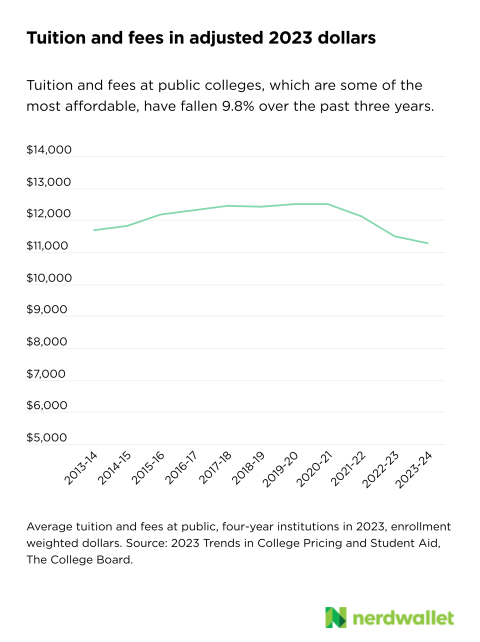2024 high school grads could face nearly $37K in college debt
By Elizabeth Renter | NerdWallet
High school graduates — and their parents — have a lot on their minds this spring, not the least of which is paying for college. Amid financial aid delays stretching months beyond what’s typical, some students are feeling pressured to make college decisions without even knowing how much they’ll be required to pay.
Still, one thing is clear: Students funding their college career with student loans could be paying for years to come. And if a student depends on loans to cover every year of their undergraduate career, they could end up owing about $37,000 when they graduate.
Tuition and fees continue to decrease
If there is good news for new college students, it’s that growth in the cost of higher education has slowed and even decreased modestly in recent years. The money spent on tuition and fees at public, four-year institutions goes further now than 10 years ago and has fallen 9.8% in just the past three years, according to data from The College Board.

However, this drop doesn’t mean higher education is affordable. On average, full-time undergraduates took out about $6,990 in student loans in the 2020-21 school year, the last year for which that data is available from the National Center for Education Statistics. Based on that figure, and a modest assumed growth rate, a NerdWallet analysis estimates a student depending wholly on loans could amass about $36,700 in student loan debt in a five-year bachelor’s degree pursuit.
Student (and parent) tip: This debt is not inevitable. Some students will have savings to draw from, and others will qualify for grants and scholarships. Determining how much to borrow each year involves estimating all of these contributions and figuring out what’s left to cover.
Often, you may qualify for more loans than you need, but you don’t have to accept the total amount available. Be conservative when accepting student loans. If you don’t accept the total award amount and discover you underestimated your need, reach out to your financial aid office. The balance that you didn’t previously accept remains available throughout the semester.
Projected student loans could surpass the federal cap
There are cumulative and annual caps on federal student loans for dependent students. These college students can’t take out more than $31,000 in federal student loans throughout their undergraduate career. So, if they borrow their way through school, they could hit these caps and be forced to find other financing options.
Private student loans and parent PLUS loans are two alternative loan options. About 10% of parents of undergraduate students took out Parent PLUS loans in 2020, according to the most recent data available from the National Postsecondary Student Aid Study. A slightly smaller share, 7%, of dependent undergraduate students used private student loans in 2020. Both of these loan types are more prevalent among middle-earning families, as lower-income families typically qualify for grants and depend less on loans overall.
Student (and parent) tip: Prioritize federal student loans after you’ve exhausted aid that doesn’t have to be repaid, and think carefully before opting for other loan types. Private student loans typically require a credit check and do not offer all of the borrower-friendly repayment options of federal student loans. Parent PLUS loans are federal loans, but they don’t have the flexibility of other federal student loans. Parents are cautioned against borrowing unless they’re on track to reach their own financial goals. About 1 in 5 parent PLUS borrowers (21%) regret taking on that debt, according to a 2021 NerdWallet survey.
Despite FAFSA hiccups, it remains a top priority
This year’s high school graduates, facing the Free Application for Federal Student Aid (FAFSA) for the first time, aren’t getting a fair introduction to the process. Financial aid award letters are going out far later than is typical because the Education Department’s FAFSA redesign and subsequent errors and fixes have stretched months longer than anyone could have expected. The annual FAFSA process is key to families’ college funding plans. Through the FAFSA, the government and colleges determine what types of financial aid a student is entitled to, including federal loans, grants and some scholarships. Ultimately, the hope is after this year’s rocky rollout, the new FAFSA will provide the streamlined experience students were promised, an improvement from the previously cumbersome and long application process.
Student (and parent) tip: Don’t let frustration over this year’s financial aid chaos discourage you from going through the motions next year and beyond. Your eligibility for grants and scholarships — money that doesn’t have to be repaid — is determined through the FAFSA’s questions about family finances. And the form must be completed every year. The application’s new format is said to be far more streamlined than in years past, so plan to carve out a little time to fill it out each fall. Your financial aid office should remind you each year when the application opens, typically Oct.1.
More From NerdWallet
The article 2024 High School Grads Could Face Nearly $37K in College Debt originally appeared on NerdWallet.